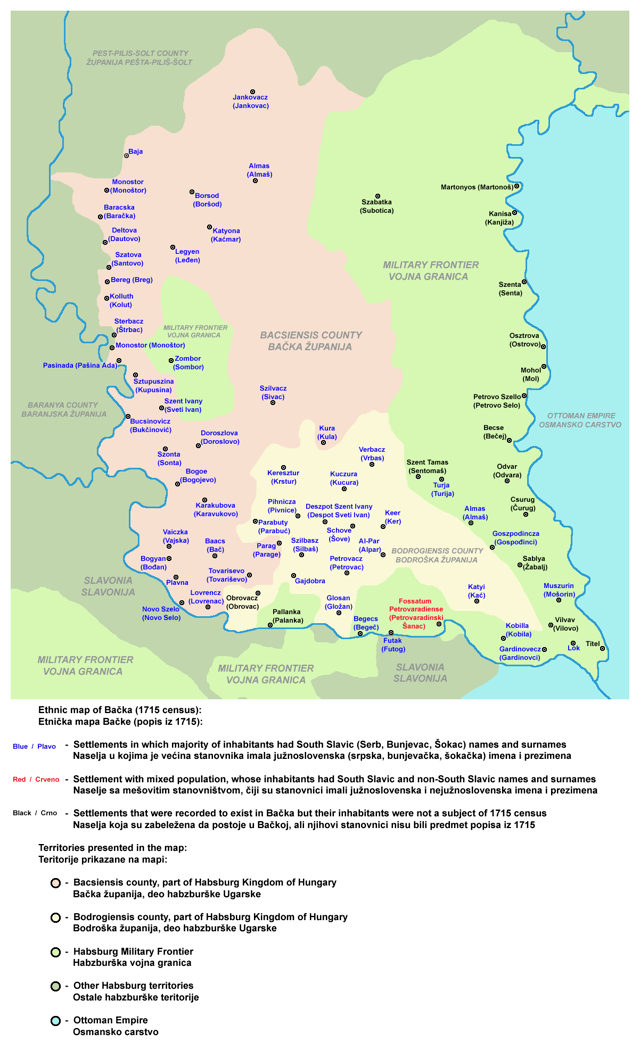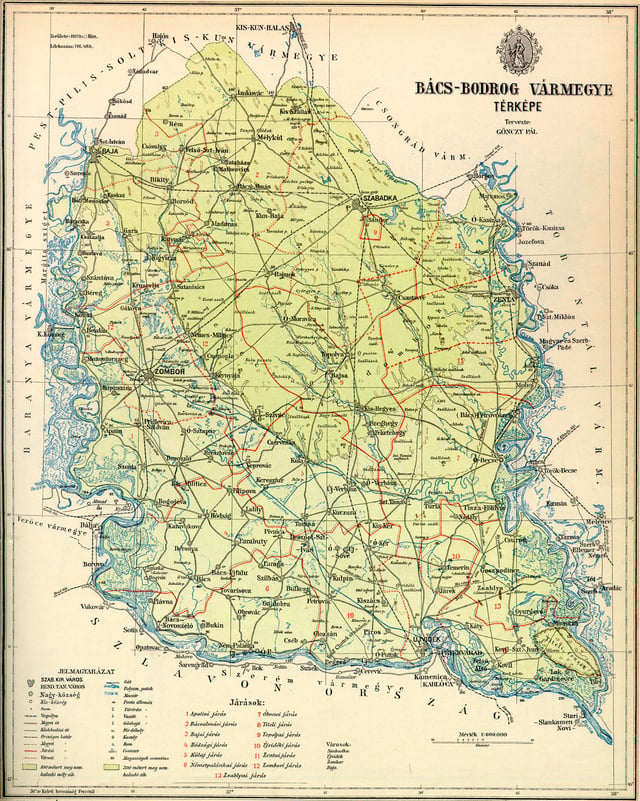Bács-Bodrog County

Bács-Bodrog County

| Bács-Bodrog County | |
|---|---|
| County of the Kingdom of Hungary in Austria-Hungary | |
| 18th century–1920 | |
 | |
| Capital | Zombor (present-day Sombor) |
| Area | |
| • Coordinates | 45°46′N 19°7′E [6] |
• 1910 | 10,362 km2(4,001 sq mi) |
| Population | |
• 1910 | 812385 |
| History | |
• Established | 18th century |
• Treaty of Trianon | 4 June 1920 |
• County recreated | 1941 |
• Abolished | 1944 1920 |
| Today part of | Serbia Hungary |
Bács-Bodrog County (Hungarian: Bács-Bodrog vármegye, German: Komitat Batsch-Bodrog, Serbian: Bačko-bodroška županija) was an administrative county (comitatus) of the Kingdom of Hungary from the 18th century to 1920. Its territory is currently in northern Serbia (western Vojvodina) and southern Hungary. The capital of the county was Zombor (present-day Sombor).
| Bács-Bodrog County | |
|---|---|
| County of the Kingdom of Hungary in Austria-Hungary | |
| 18th century–1920 | |
 | |
| Capital | Zombor (present-day Sombor) |
| Area | |
| • Coordinates | 45°46′N 19°7′E [6] |
• 1910 | 10,362 km2(4,001 sq mi) |
| Population | |
• 1910 | 812385 |
| History | |
• Established | 18th century |
• Treaty of Trianon | 4 June 1920 |
• County recreated | 1941 |
• Abolished | 1944 1920 |
| Today part of | Serbia Hungary |
Name
The county was named after two older counties: Bács and Bodrog. Bács county was named after a town of Bács (present-day Bač) and the Bodrog county was named after a historical town of Bodrog (which was located near present-day Bački Monoštor), which itself was named after a Slavic tribe Abodrites (or Bodrići in Slavic) that inhabited this area in the Middle Ages. The Abodrites were originally from northwest Germany, but after their homeland fell to the Germans, some had moved to Pannonia.
Geography
Bács-Bodrog county shared borders with several other counties of the Kingdom of Hungary: Baranya, Pest-Pilis-Solt-Kiskun, Csongrád, Torontál, Syrmia, and Virovitica (the latter two counties were part of autonomous Kingdom of Croatia-Slavonia). The river Danube formed its western and southern border. The river Tisza formed its eastern border, down to its confluence with the Danube. Its area was 10,362 km² around 1910.
History

Bach and Bodrogh counties in the 14th century

Bács-Bodrog, Syrmia, Torontál, Temes and Krassó-Szöreny counties after 1881, the five counties, which were formed in the territory of former Voivodeship of Serbia and Banat of Temeschwar
Bács county arose as one of the first comitatus of the medieval Kingdom of Hungary, in the 11th century. Bodrog county was also formed in the 11th century.[1] The area was taken by the Ottoman Empire in the 16th century [2] and two counties were abolished. During the Ottoman administration, the area of the former counties was part of the Sanjak of Segedin. The Batsch and Bodrog counties were established again after the Batschka region was captured by the Habsburg Monarchy in 1699 [3] (The two counties were joined into single Batsch-Bodrog county in the 18th century). Some (mostly eastern) parts of the Batschka were incorporated into the Theiß-Marosch section of Military Frontier.[3] After this part of Military Frontier was abolished in 1751, these parts of the Batschka were also included into Batsch-Bodrog county. The only part of the Batschka region, which remained within Military Frontier was Šajkaška, but it also came under civil administration in 1873.
In 1848/1849 the area of the county was part of Serbian Voivodeship, while between 1849 and 1860 it was part of Voivodeship of Serbia and Banat of Temeschwar, a separate Habsburg province. During this time the county did not existed since area was divided into districts. The county was recreated in the 1860s, when Voivodeship of Serbia and Banat of Temeschwar was abolished and area was again incorporated into the Habsburg Kingdom of Hungary (since 1867, Kingdom of Hungary is one of two autonomous parts of Austria-Hungary).
By the Treaty of Trianon of 1920, territory of the county was divided between the Kingdom of Serbs, Croats and Slovenes and Hungary. Most of the county (including Sombor, Subotica, and Novi Sad) was assigned to the Kingdom of Serbs, Croats and Slovenes (renamed to Yugoslavia in 1929), while the northernmost (approximately 15% of the county), including town of Baja, was assigned to Hungary.
Aftermath
Until 1922, the southern part of the former Bács-Bodrog county was a county of the Kingdom of Serbs, Croats and Slovenes with a seat in Novi Sad. The northern part of the former county had been a county within Hungary since 1921. The capital of this smaller Hungarian county Bács-Bodrog was Baja. After World War II Bács-Bodrog was united with the southern part of former Pest-Pilis-Solt-Kiskun county to form the Bács-Kiskun county.
The Yugoslav part of the pre-1920 Bács-Bodrog county was occupied and annexed by Hungary during World War II (see Occupation of Vojvodina, 1941-1944) and the Bács-Bodrog county was recreated in 1941. The border between Yugoslavia and Hungary was restored in 1947 by the Paris Peace Treaties and the county was abolished again. Yugoslav part of former Bács-Bodrog county was later divided into 3 districts and currently is part of Serbia, autonomous region of Vojvodina.
Demographics

Ethnic map and political division of the area in 1715
During the 18th century, the Habsburgs carried out an intensive colonisation of the area, which had low population density after the last Ottoman wars. The new settlers were primarily Serbs, Hungarians, and Germans. Because many of the Germans came from Swabia, they were known as Donauschwaben, or Danube Swabians. Some Germans also came from Austria, and some from Bavaria and Alsace. Lutheran Slovaks, Rusyns, and others were also colonized but to a much smaller extent.
According to the Austrian census from 1715, Serbs, Bunjevci, and Šokci comprised 97.6% of the county's population.
The 1720 census recorded 104,569 citizens in the county. Of those, there were 98,000 Serbs (divided into 76,000 Orthodox and 22,000 Roman Catholics or Bunjevci and Šokci), 5,019 Magyars and 750 Germans. The Serbs (73%) and Bunjevci and Šokci (21%) had an overwhelming majority in the county which seems to have been inhabited solely by them.
There was also an emigration of Serbs from the eastern parts of the region, which belonged to Military Frontier until 1751. After the abolishment of the Theiß-Maros section of Military Frontier, many Serbs emigrated from north-eastern parts of Batschka. They moved either to Russia (notably to Nova Serbia and Slavo-Serbia) or to Banat, where Military Frontier was still needed.
By 1820 the county had grown to 387,914 in total population. The Serb (including Bunjevci and Šokci) share had dropped to 44% or 170,942 with the number of Hungarians plummeting at 121,688 and Germans at 91,016 or 31% and 23% respectively.
1900
In 1900, the county had a population of 766,779 people and was composed of the following linguistic communities:[4]
Total:
According to the census of 1900, the county was composed of the following religious communities:[5]
Total:
Roman Catholic: 498,216 (65,0%)
Greek Orthodox: 138,344 (18,0%)
Lutheran: 68,526 (8,9%)
Calvinist: 29,261 (3,8%)
Jewish: 18,793 (2,5%)
Greek Catholic: 10,814 (1,4%)
Unitarian: 59 (0,0%)
Other or unknown: 2,766 (0,4%)
1910

Ethnic map of the county (with data of the 1910 census). Key: red - Hungarians; pink - Germans; light green - Slovaks; light blue - Croatians; dark blue - Serbs; violet - Ruthenians; black - Roma. Coloured dots in plain rectangles imply the presence of smaller minority populations (generally more than 100 people or 10%). Multicoloured rectangles imply cities and villages with multi-ethnic populations with the order of the stripes following the ethnic composition of the settlement.
In 1910, the county had a population of 812,385 people and was composed of the following linguistic communities:[4]
Total:
According to the census of 1910, the county was composed of the following religious communities:[5]
Total:
Roman Catholic: 534,682 (65,8%)
Greek Orthodox: 146,015 (18,0%)
Lutheran: 70,098 (8,6%)
Calvinist: 29,772 (3,7%)
Jewish: 18,244 (2,3%)
Greek Catholic: 11,684 (1,4%)
Unitarianist: 65 (0,0%)
Other or unknown: 1,825 (0,2%)
As for the geographical distribution of the three largest ethnic groups in 1910, Hungarians mainly lived in northern parts of the county, Germans in western, and Serbs in the southern parts. The city of Újvidék in the southern part of the county was the cultural and political centre of the Serb people in the 18th and 19th century.
Subdivisions

Detailed map of the county
In the early 20th century, the subdivisions of Bács-Bodrog county were:
| Districts (járás) | |
|---|---|
| District | Capital |
| Apatin | Apatin (Serbian: Apatin) |
| Bácsalmás | Bácsalmás |
| Baja | Baja |
| Hódság | Hódság (Serbian: Odžaci) |
| Kula | Kula (Serbian: Kula) |
| Óbecse | Óbecse (Serbian: Stari Bečej, today Bečej) |
| Palánka | Palánka (Serbian: Stara Palanka, today Bačka Palanka) |
| Titel | Titel (Serbian: Titel) |
| Topolya | Topolya (Serbian: Topola, today Bačka Topola) |
| Újvidék | Újvidék (Serbian: Novi Sad) |
| Zenta | Zenta (Serbian: Senta) |
| Zombor | Zombor (Serbian: Sombor) |
| Zsablya | Zsablya (Serbian: Žabalj) |
| Urban counties (törvényhatósági jogú város) | |
| Baja | |
| Szabadka (Serbian: Subotica) | |
| Újvidék (Serbian: Novi Sad) | |
| Zombor (Serbian: Sombor) | |
| Urban districts (rendezett tanácsú város) | |
| Zenta (Serbian: Senta) | |
The towns Baja and Bácsalmás are now in Hungary; the other towns mentioned are now in Serbia.


